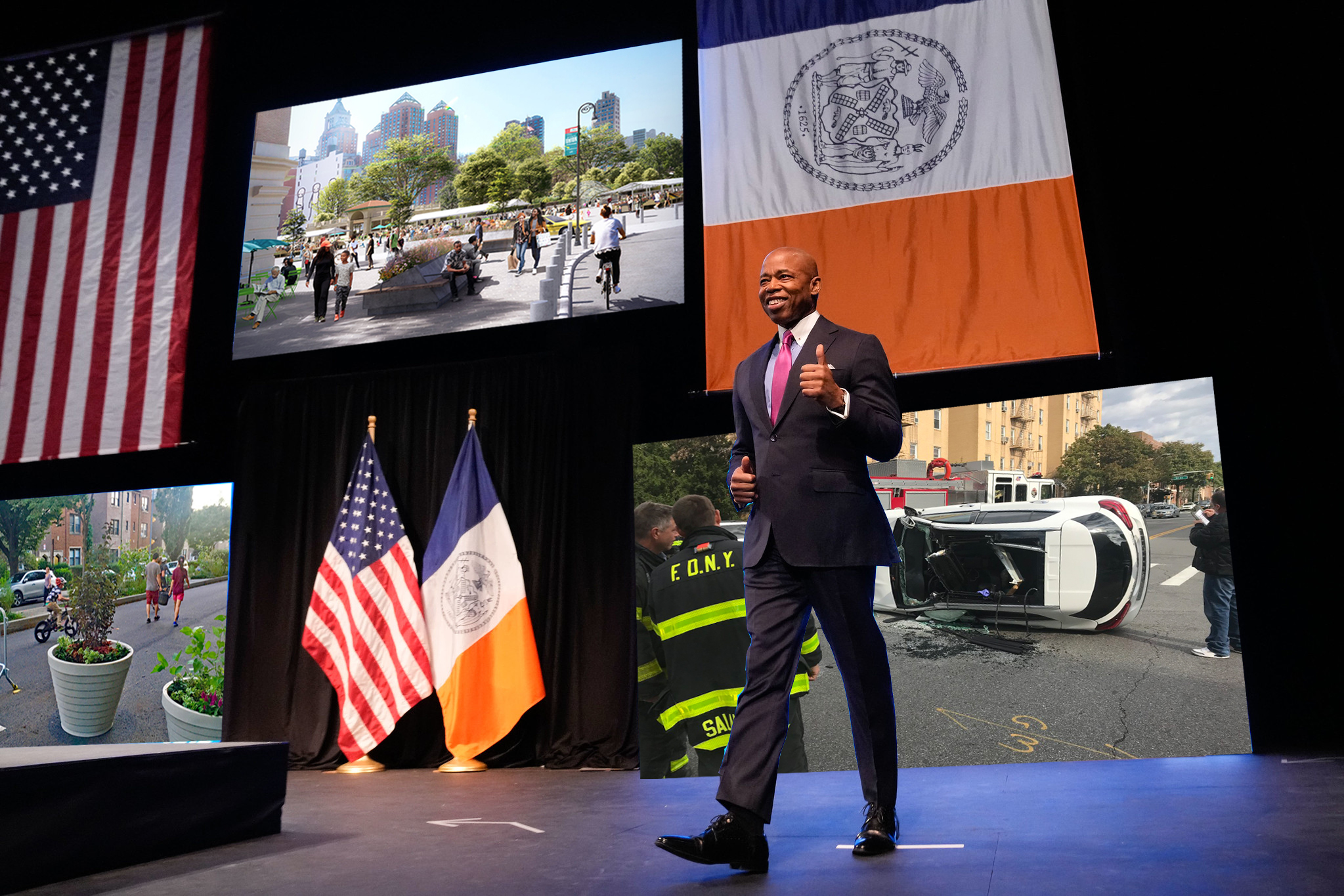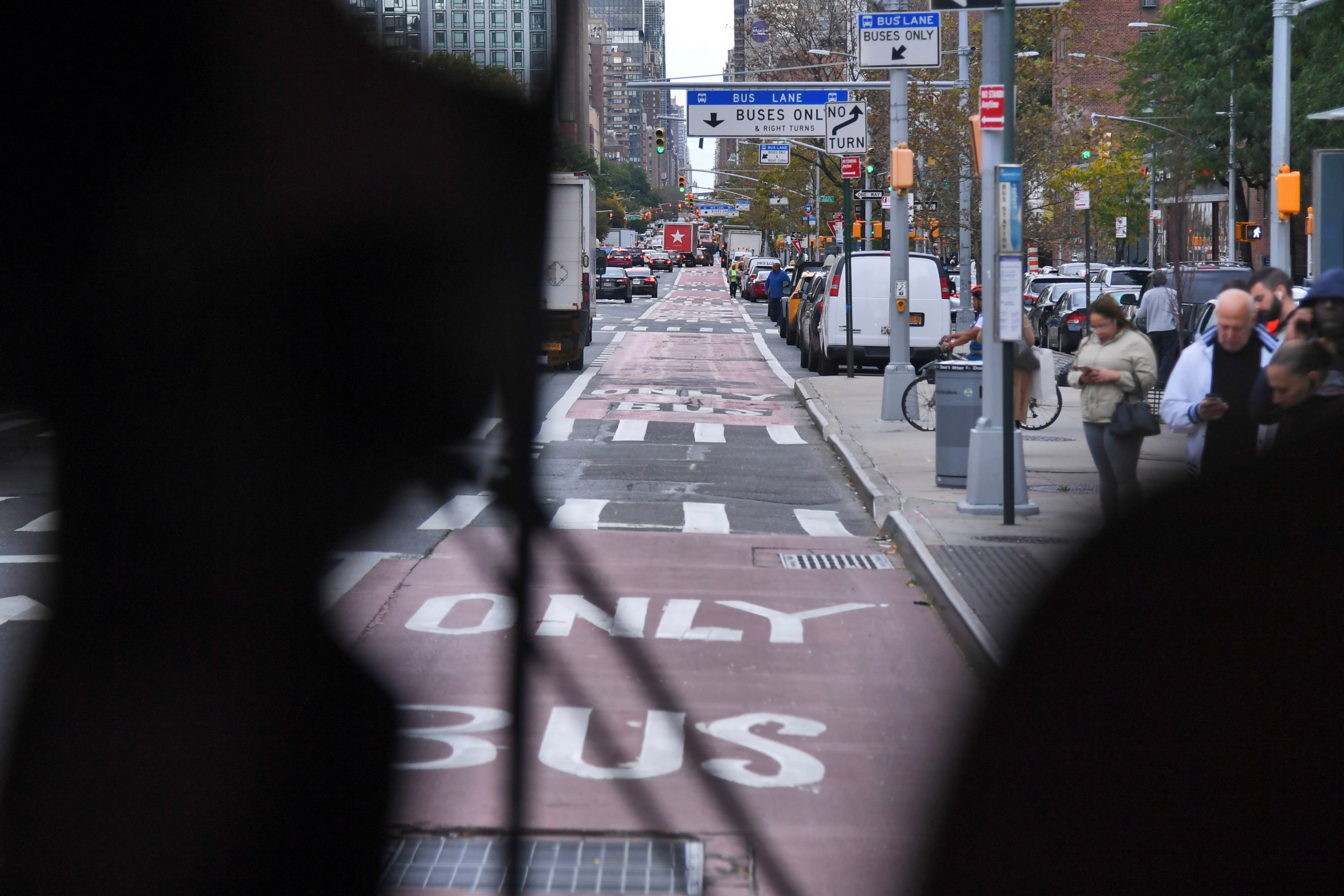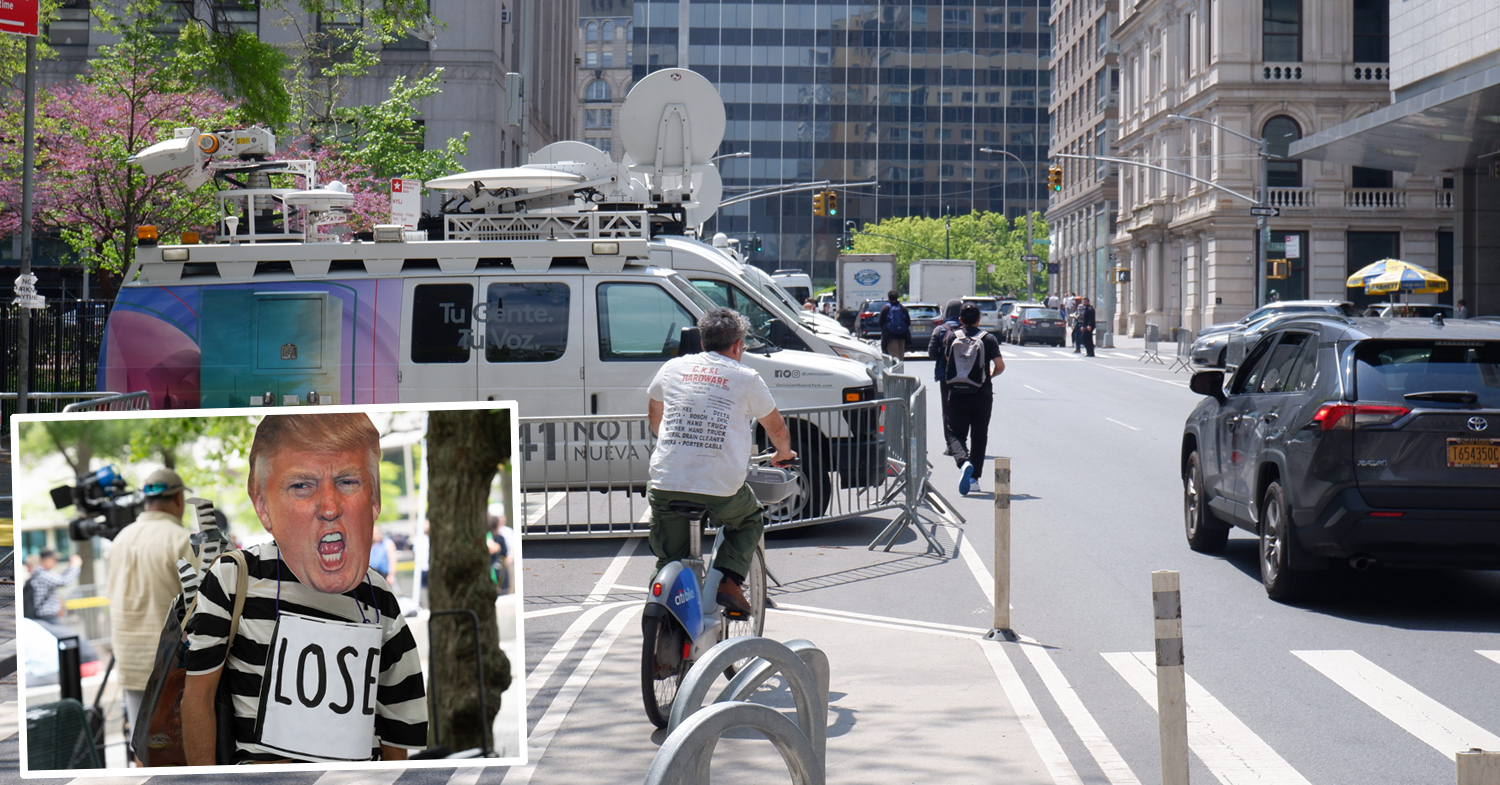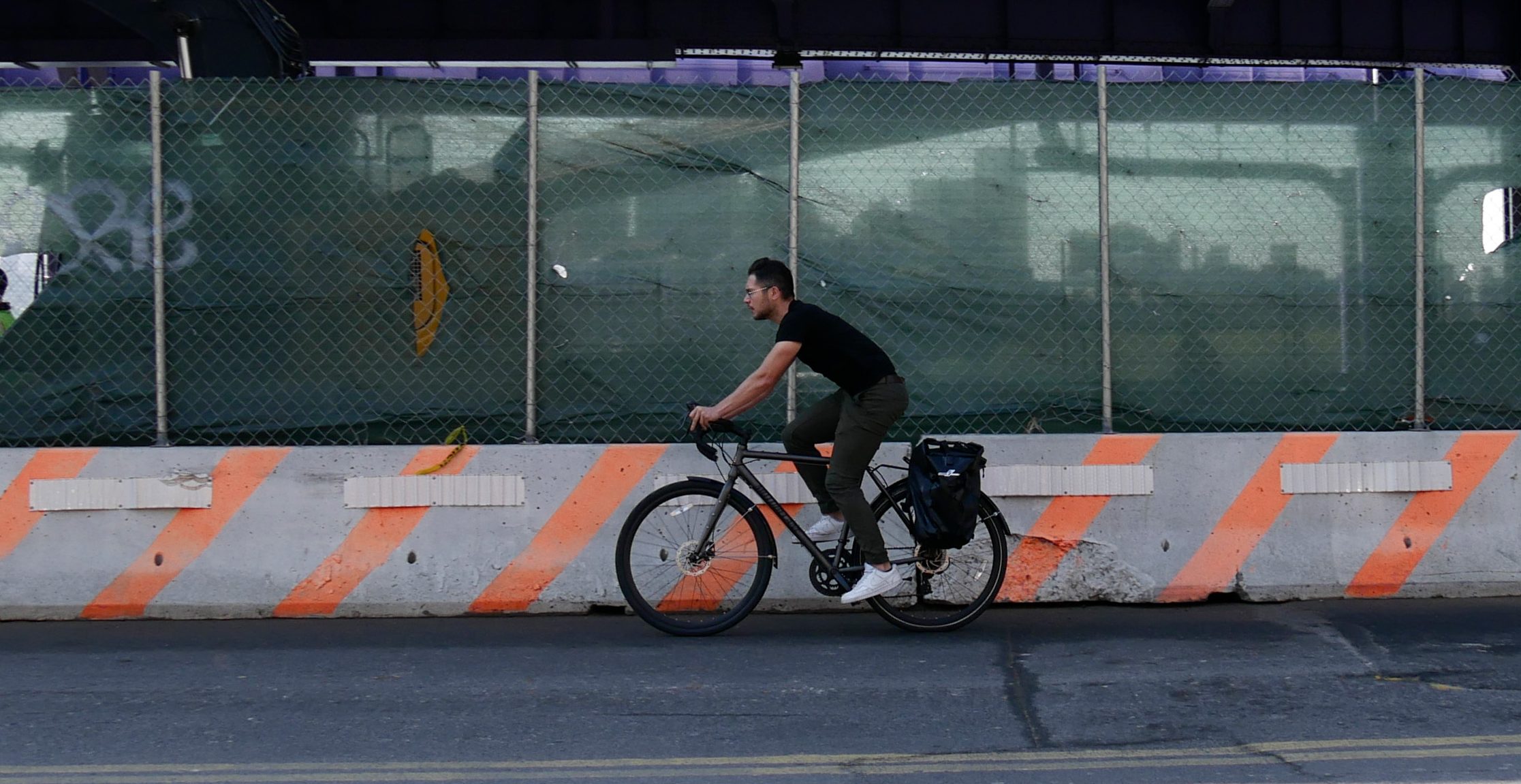ANALYSIS: The Mayor’s State of the City: Something For Everyone (But Not Enough)
3:54 PM EST on January 26, 2023

Mayor Adams at his state of the city address on Thursday. Photo: Michael Appleton/Mayoral Photography Office (with additions made by the Streetsblog Photoshop Desk)
Mayor Adams's State of the City address offered a number of initiatives that will be received warmly by livable streets activists, including a spate of public space redesigns, a package of bills to hold reckless drivers accountable and a proposal to reduce emissions from taxis.
That said, some activists were quick to point out what wasn't in the speech, such as specific transit improvements, a wide spate of road design projects or more support for transportation equity.
"Working New Yorkers need transit equity, which means City Hall must deliver faster buses and more affordable fares," Riders Alliance Executive Director Betsy Plum said in a statement. "Better public transit binds the whole city together, increasing access to jobs, education, healthcare and more for the New Yorkers who need it most. Mayor Adams promised millions of riders that he would speed up the nation's slowest bus system with 150 new bus lane miles over four years. So far, we've seen barely more than we can count on one hand. The administration must pick up its own pace so bus riders can pick up ours.
"The city's Fair Fares program is the largest low-income transit discount program in the nation, but achieving its promise requires expanding eligibility," Plum added. "Mayor Adams should offer half fare cards to a million more low-income New Yorkers earning up to 200 percent of the federal poverty line."
Many groups issued positive statements about the specifics in the speech, but the general praise was undercut by the shortcomings.
"In all, Adams missed the opportunity to champion a livable city," Open Plans said in a statement. "Eliminating parking mandates as part of the City of Yes Zoning reform, expanding Summer Streets to Brooklyn and Queens (supported by each borough’s presidents), trash containerization, taking on car dependence, and reducing the city fleet were all missing. ... To build a truly vibrant future, we must employ new solutions that center our people and places."
But what's beyond the few lines in the speech? The Streetsblog team fanned out on Thursday afternoon to put some meat on Hizzoner's rhetorical bones. Here's what he said and what we found out:
Street initiatives
The speech promised that the city "will make a game-changing $375-million investment to create extraordinary new public spaces and permanent open streets in all five boroughs, including:
- The Broadway Vision plan to connect Madison Square to Greeley Square between 21st and 33rd streets;
- Unlocking two spaces under the Brooklyn Bridge in Manhattan for public use with a working group to evaluate medium- and long-term concepts for these spaces and others nearby;
- Additional high-quality pedestrian space around the perimeter of Court Square Park and along Thomson Avenue and Court Square West in Long Island City;
- A full reconstruction of Jamaica Avenue from Sutphin Boulevard to Merrick Boulevard in Jamaica;
- Permanent upgrades to the open street on Willis Avenue between East 147th Street and Bergen Avenue in the Bronx with a bike lane, pedestrian safety improvements, and public space beautification; and
- Permanent improvements to the Minthorne Street open street on Staten Island, with expanded pedestrian space at Tompkinsville Park and a new plaza at Central Avenue."
Streetsblog reached out to the Department of Transportation for further details and will update this story when we hear back, but some elements of this, such as greater pedestrianization of Broadway, have been previously discussed.
The mention of the spaces under the Brooklyn Bridge might be a reference to a larger effort by a group called "Gotham Park" to use the space under the various highway on and off ramps. The group is actively working to restore the so-called Brooklyn Banks, an iconic skate spot that closed in 2010 when roadwork was done and has not reopened.
The group also has plans for a space called "The Vaults" which are inside the bridge support structure itself.
"We envision The Vaults would be converted to public use, ideally a New York Public Library combined with a Brooklyn Bridge Museum housing a collection of documents and artifacts from the design and construction of the Brooklyn Bridge, because it is nice to be inspired to do things once thought impossible," the group said on its website. (Streetsblog reached out and will update this story if we hear back. It is not clear if Adams's mention of the Brooklyn Bridge was in connection or in contradiction to this group's work.)
UPDATE: After initial publication of this story, the Department of Transportation sent over more details (including that the $375 million is new money not previously allocated):
- Broadway Vision:
- The street improvement project will be implemented this year, and will include two plazas, shared streets, and two-way cycling connections
- A capital project will follow to build out painted Broadway Vision treatments with concrete upgrades between Flatiron and Herald Square
- Brooklyn Bridge
- Unlocking spaces currently being used for construction staging for public space
- A working group will look at longer-term concepts for this space and others in the area
- Initial spaces will open this year
- Long Island City
- New shared street along Court Square West
- Jamaica
- The reconstruction will include widened sidewalks and pedestrian safety improvements including curb extensions, and adding raised crosswalks
- Capital construction to follow
- Willis Avenue
- Permanent open street build-out will include a grade-separated two-way bike path, pedestrian safety improvements, and streetscape/landscaping
- Minthorne
- Permanent build-out into a shared street with expanded public space, connecting to the transformative Bay Street public realm improvements which include new plaza at Central Ave and expanded pedestrian space at Tompkinsville Park
- Capital project in design
Help from Albany
Regarding street safety, Adams's speech said the administration would be focused this year "on holding reckless drivers accountable."
The mayor said he'll push Albany "to advance a package of six bills called Removing Offenders and Aggressive Drivers from Our Streets (ROADS) to increase penalties for serious crashes, running red lights, and impaired driving. The ROADS legislative package would also ensure swift and serious consequences for those who drive with suspended or revoked licenses, including by revoking the privilege of driving on city streets and suspending the registration of vehicles that collect five or more red light camera violations within a 12-month period."
The city, of course, had difficulty with getting some of the more punitive measures through Albany last year during the push to expand speed and red light cameras. At the time, the administration backed the failed effort that would have, among other things, suspended the registration of vehicles that got six camera-issued tickets in a two-year period.
The mayor's office did not expand on what bills are in the ROADS Act. However, State Sens. Mike Gianaris and Andrew Gounardes have sponsored bills with similar aims as Adams talked about on Thursday. Gianaris's bill, which was first introduced during the 2017-18 session and has been reintroduced every year since, suspends the registration of a vehicle that's been dinged by a red light camera five times in 12 months.
Gounardes's bill, which has not yet been introduced, reclassifies "reckless driving" as "dangerous driving." Doing so would remove the legal burden from prosecutors to prove that someone not only drove in a reckless manner but also knew that they were driving in a way that could cause other people death or serious injury, a standard known as the "rule of two."
Gounardes couldn't say anything about Adams's specific bills, but he's ready to help.
"The ROADS Act, as mentioned by Mayor Adams today, could save hundreds of lives each year, and would be crucial in achieving Vision Zero, once and for all. I strongly support any and all efforts to crack down on reckless drivers and to keep our streets safe for all. I look forward to partnering with Mayor Adams to achieve that goal," he said.
Local law enforcement
Perhaps Streetsblog can take a tiny bit of credit for one line in Adams's speech? On Thursday, the mayor promised to "expand the community response teams to operate at the borough level and address everything from ghost license plates to noise complaints and property crimes."
Certainly, ghost cars have been on Adams's radar screen since he announced a crackdown last year, but Hizzoner was no doubt reminded of it thanks to a series of videos posted on Twitter by Streetsblog Editor Gersh Kuntzman on the administration's failure to crack down on covered and defaced plates, which help drivers avoid speed cameras. Coverage of Kuntzman's crusade was featured in Gothamist, NY1, the New York Times and even the New Yorker.
The mayor also promised to "increase the number of NYPD tow trucks to address the growing number of abandoned or illegally parked cars blocking traffic and visibility, help keep delivery zones and bus and bike lanes clear, and crack down on illegal placards and placard abuse."
The paucity of NYPD tow trucks has long been cited as a primary reason why periodic crackdowns must be done on a one- or two-precinct-at-a-time basis.
Clean cars
Adams announced that someone else would do the job of cleaning up the city's taxi fleet — but he definitely supports it.
He said the city would build on its own smaller fleet electrification by "requiring the 100,000-plus high-volume for-hire vehicles to do the same — requiring them, with the support of Uber and Lyft, to be zero-emissions by 2030, with no new costs for individual drivers."
That sounds like a monumental task, but Uber spokesman Josh Gold said the company applauded "the mayor's ambition for reducing emissions."
"Uber has been making real progress to become the first zero-emissions mobility platform in North America, and there’s much more to do," he added. "We look forward to working with the TLC to achieve zero-emissions in New York City in a way that benefits drivers, riders, and the city."
Lyft took a more "been-there-wanted-that" approach.
“Three years ago, we announced our commitment to reach 100 percent electric vehicles on the Lyft platform by 2030. We are excited to partner with New York City on our journey," said Paul Augustine, Lyft’s Director of Sustainability. "New York’s commitment will accelerate an equitable city-wide transition to electric, and we’re eager to collaborate with the TLC on an ambitious plan for a rideshare clean mile standard. With smart, targeted investments in incentives and charging infrastructure, we’ll help tear down the barriers that prevent drivers from making the switch to electric — and build a cleaner and more sustainable New York in the process.”
Taxi and Limousine Commissioner David Do told Streetsblog that specifics would come "in the coming weeks."
The city's push to electrify the taxi fleet is a turnaround from 2021, when the city specifically blocked Revel from introducing new electric taxis into the market.
Unfinished business
The mayor reiterated his earlier promise to "appoint a new director of the public realm to coordinate across city government, community organizations, and the private sector to ensure we invest in public spaces citywide." This is long a dream of many street safety and public space advocacy groups.
“The mayor’s announcement of a Director of the Public Realm is a victory for New York,” said Jackson Chabot, director of advocacy and organizing for Open Plans. “We’ve seen that well-managed public space is at the heart of economic vitality and community. Now the city must seriously commit to building public space equitably across all five boroughs. That means central leadership through the new director, as well as on-the-ground support, prioritzing people-centered street design, and a mindset that cultivates streets, sidewalks and plazas as inclusive public space for everyone.”
The mayor was a bit vague on his hopes for the open restaurant program, currently stalled in the Council, saying only that he would "work with the City Council to build on the massive success of the pandemic-era temporary program and deliver a permanent program that actually works for businesses and residents in all five boroughs." The mayor did not reiterate his demand that the program remain inside the Department of Transportation rather than have it (as the current Council proposal calls for) revert back to the Department of Consumer and Worker Protection, which has long run the outmoded sidewalk cafe program.
Open Plans recently had an op-ed in amNY calling for action in the Council. On Thursday, the group seemed surprised that Adams didn't speak more definitively.
"In order for the program to create the most value for New Yorkers and business owners, it must be managed by DOT, year-round, and on a sliding fee scale," the group said.
— full team coverage by Dave Colon, Julianne Cuba, Kevin Duggan and Gersh Kuntzman
This piece was the work of the Streetsblog staff.
Stay in touch
Sign up for our free newsletter
More from Streetsblog New York City
EXCLUSIVE: OMNY Debuts on Fair Fares After Delays
The long-awaited Fair Fares expansion will launch as a three-month pilot for a few dozen riders.
Good Luck Docking Your Citi Bike In Lower Manhattan
Many frustrated commuters to Lower Manhattan opted to simply abandon their Citi Bikes undocked due to the lack of open spots in the area.
Wednesday’s Headlines: ‘ACE’ in the Hole Edition
The MTA approved a $141-million contract to put hundreds of new automated traffic enforcement cameras on buses. Plus more news.
Trump Trial Street Closures Push Pedestrians, Cyclists into Busy Traffic
News vans have dangerously blocked the sidewalk and bike lane on Lafayette Street daily since Donald Trump's trial began nearby two weeks ago.
Eyes On The Street: Coastal Resiliency Causes Mess For Pedestrians and Cyclists
Unfortunately for cyclists and pedestrians, this situation won't be fixed until "at least 2026.”




